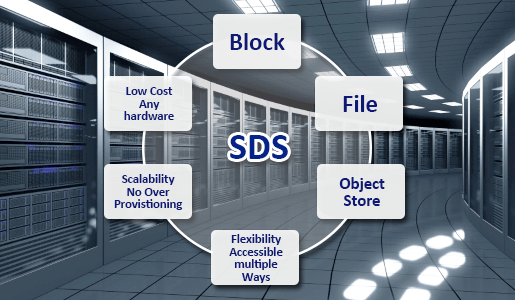Software-Defined Storage and its Types
Software-defined storage is a storage system that does not simply depend on the underlying hardware. Rather, software is used for the purpose of managing data. The majority of data storage products do need both software and hardware to function. While software tends to serve as a management component that helps in controlling and monitoring the storage tasks in traditional systems, software-defined storage differs.
Earlier, Anand Jayapalan had discussed how software-defined storage describes products that run on commodity server hardware without any kind of specially built hardware components. These storage solutions are better suited to eradicate expenses, rather than traditional hardware-dependent storage products. By choosing to abstract resources from hardware, businesses can enjoy better scalability, efficiency, performance, and flexibility. Storage resources ideally lend themselves better to programming in this manner. Hence, they become key components of a software-driven datacenter. These resources are much easier to automate in comparison to those living in siloed infrastructure.
Software-defined storage is pretty much a general term, and due to this, identifying types of SDS products can be unclear. However, there are certain generally recognized categories that come under the software-defined storage umbrella. Types of Software-Defined Storage:
- Block, file, and object storage: This category makes use of a distributed server cluster for the purpose of supporting the three main varieties of storage solutions, which is to block, file, and object. Block, file, and object storage system allows businesses to use whichever method they prefer, along with a unified management system.
- Scale-out object: This system develops and allocates a unique identifier to the object. Certain object storage solutions can also support file access, including SMB and NFS.
- Scale-out block: Making use of x86 server nodes, block storage products cluster such nodes into a single system. The result is that businesses are able to enjoy coherent communication between nodes.
- Scale-out file: This is the earliest software-defined storage category, and is known to create highly available scale-out file shares to use with file-driven application storage.
- Storage virtualization: This system takes hardware-based storage solutions across distinctive locations and creates a single storage device that might be used and monitored through a single management platform.
Storage virtualization is an important component needed for software-defined storage to work. Storage virtualization is known to be used to separate storage hardware and storage management software. This often includes policy management for snapshot, backup, and replication purposes. Software defined storage helps create a consolidated virtual pool for disk arrays. Virtual disks are formed from there and appear as local unit numbers (LUNs) in a host server. Earlier, Anand Jayapalan had mentioned that while software-defined storage prospects may see the value of adopting the solution, companies must consider the advantages and risks linked with sticking to a legacy, hardware-based storage strategy.
Business owners must be aware of the fact that there is a breaking point with a traditional storage solution. With time, increasingly complex applications are springing up with unique demands, and a massive influx of data is putting pressure on traditional storage. As a result, expectations of what a storage strategy can and should do are changing. Businesses of today need greater flexibility than legacy storage can provide, and hence software-defined storage becomes highly vital.



